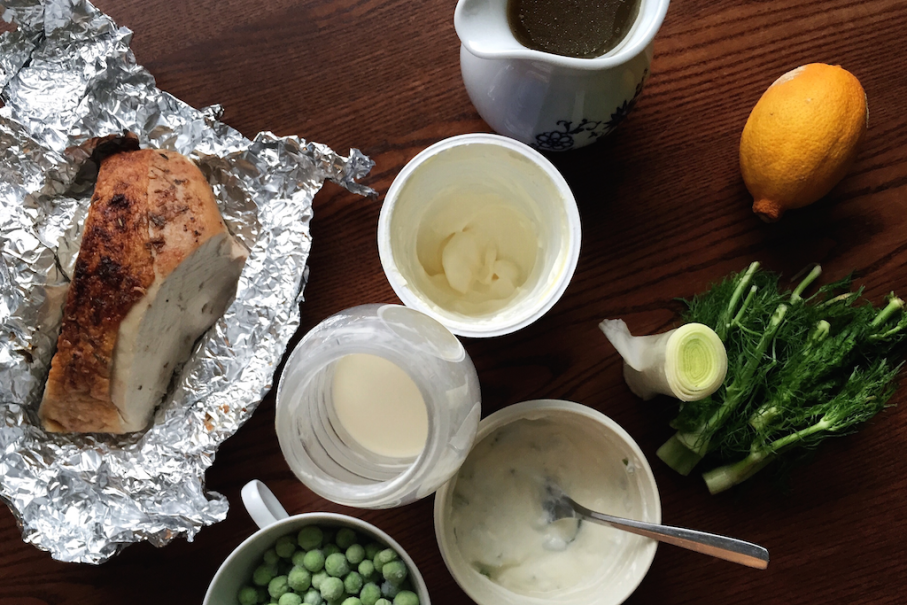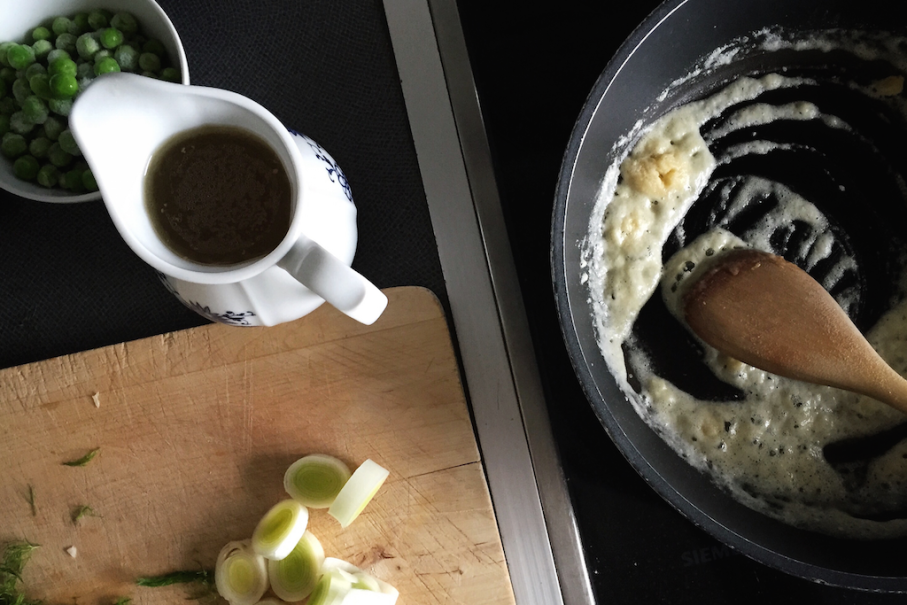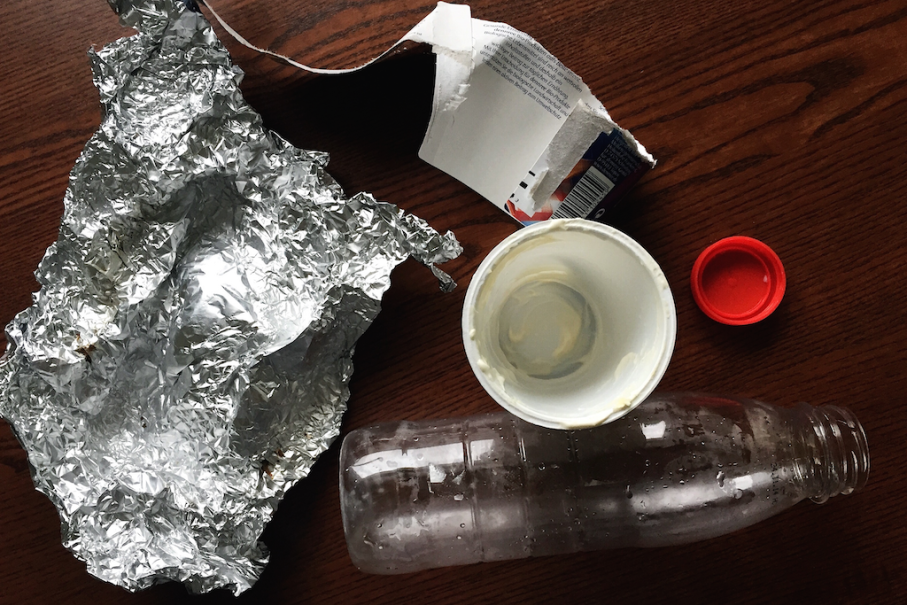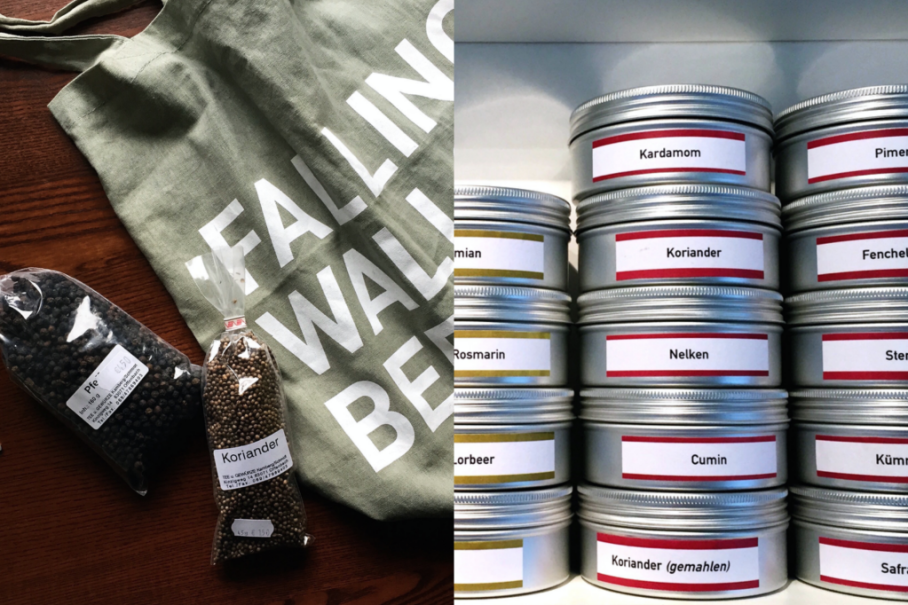 Did you know that last week was the European Week for Waste Reduction? I learned about it when I was randomly surfing around the net the other week and stumbled upon an article on the ‘Zero Waste Lifestyle’. Meanwhile, I have done a bit of binge reading on the topic, and I am HOOKED on the idea of reducing the amount of waste I produce to an absolute minimum. So much so that I want to share a few thoughts on it with you today, along with this homey turkey fricassee, with tender and juicy turkey meat, sweet peas, crunchy leeks and a lusciously creamy and lemony dill-sauce. How they go together? My delicious lunch for two is entirely made of leftover bits and pieces I found on a little fridge forage – a taste of zero waste.
Did you know that last week was the European Week for Waste Reduction? I learned about it when I was randomly surfing around the net the other week and stumbled upon an article on the ‘Zero Waste Lifestyle’. Meanwhile, I have done a bit of binge reading on the topic, and I am HOOKED on the idea of reducing the amount of waste I produce to an absolute minimum. So much so that I want to share a few thoughts on it with you today, along with this homey turkey fricassee, with tender and juicy turkey meat, sweet peas, crunchy leeks and a lusciously creamy and lemony dill-sauce. How they go together? My delicious lunch for two is entirely made of leftover bits and pieces I found on a little fridge forage – a taste of zero waste.
 Waste is a curious thing. It’s everywhere: in the streets, on the subway, in national parks, in the oceans and on the shores, and, as you and I know all too well, in our households. And there, the kitchen may be the one place where we produce most of our waste. Think of all the aluminum foil, cling film, cans, milk cartons, plastic packaging, and not to forget: all the food going to waste. Food waste has been a topic close to my heart for a long time. Over 100 million tonnes of food are wasted annually in the EU alone. That’s 100.000.000.000 kg for you. And current estimates are: there will be even more 5 years from now. I try to be a zero waste kitchen as much as I can by buying smart, storing smart and cooking smart. Buying smart to me is buying a reasonable amount and choice of things that we will surely eat up before they go bad, and to choose options with longer natural shelf life, such as a whole piece of bacon which I will keep in a cold place rather than plastic wrapped individual strips. Also, I’m a regular at the local farmer’s market. I just cannot get any fresher produce anywhere – and I wouldn’t even want to try since there is a lot of practical wisdom about storing and treating produce to be gained for free on the market. Storing smart is the key to keeping the food I bought fresh and usable for as long as possible. I try to store things in the particular way they need to be stored: vegetables in the vegetable drawer of my fridge (those in danger if wilting I keep in a wet towel), meats directly above, cheeses on the top shelve, never in air-tight containers to avoid mold, and so on. Also, I keep track of the things I have and when they have to be eaten. I put those in the front row to remind myself of using them. I will write more on these two points in a future post, if you’re interested. Let me know in the comment section – and also let me know about your strategies, I’m eager to learn about them!
Waste is a curious thing. It’s everywhere: in the streets, on the subway, in national parks, in the oceans and on the shores, and, as you and I know all too well, in our households. And there, the kitchen may be the one place where we produce most of our waste. Think of all the aluminum foil, cling film, cans, milk cartons, plastic packaging, and not to forget: all the food going to waste. Food waste has been a topic close to my heart for a long time. Over 100 million tonnes of food are wasted annually in the EU alone. That’s 100.000.000.000 kg for you. And current estimates are: there will be even more 5 years from now. I try to be a zero waste kitchen as much as I can by buying smart, storing smart and cooking smart. Buying smart to me is buying a reasonable amount and choice of things that we will surely eat up before they go bad, and to choose options with longer natural shelf life, such as a whole piece of bacon which I will keep in a cold place rather than plastic wrapped individual strips. Also, I’m a regular at the local farmer’s market. I just cannot get any fresher produce anywhere – and I wouldn’t even want to try since there is a lot of practical wisdom about storing and treating produce to be gained for free on the market. Storing smart is the key to keeping the food I bought fresh and usable for as long as possible. I try to store things in the particular way they need to be stored: vegetables in the vegetable drawer of my fridge (those in danger if wilting I keep in a wet towel), meats directly above, cheeses on the top shelve, never in air-tight containers to avoid mold, and so on. Also, I keep track of the things I have and when they have to be eaten. I put those in the front row to remind myself of using them. I will write more on these two points in a future post, if you’re interested. Let me know in the comment section – and also let me know about your strategies, I’m eager to learn about them!
 Thirdly, and maybe most importantly, I try to cook smart. To me, that means first and foremost: using every bit of the plant or animal that I can. When I buy oranges for juicing, I peel off the aromatic orange zest first and freeze it, dry it, use it to aromatize salt or sugar, or whatever. Same goes for vanilla pods: When they’re empty, I put them in a jar with sugar to make vanilla sugar. Especially with meat, my ethical concerns are not so much about eating animals at all than about treating this precious resource responsibly in my cooking. The stock I used in my turkey fricassee is made from the leftover carcass of my roasted Thanksgiving turkey. I removed all the meat we couldn’t eat (and froze it) after dinner and cooked the carcass for one hour, with a few spices and the peels and trimmings of the carrots, celery and leeks I used to make the sauce the day before. (The last resort with almost anything for me is to turn it into stock and preserve that. A good, homemade stock without preservatives and the flavor profile you want is always good to have around: as a base for soups and sauces, or to make risotto. In professional kitchens, the ‘grand jus’, a large pot of simmering broth to which all the trimmings are added to deepen the flavor over the course of the day, is indispensable). The drippings from the roasting pan I keep for future sauces, the skin is in the freezer for now, but will be crisped up on the weekend and crumbled over mashed potatoes. Repurposing leftovers and turning them into ‘bestovers’ is one of my key strategies to save food from going to waste. The small gulp of whipping cream, two tablespoons of sour cream with chives, that dried and not-so-pretty lemon and the cut-off fennel greens would’t be much on their own. But combined with a little frozen peas and the turkey, they make for a delectable lunch. And photographed in the right light – you wouldn’t guess the whole dish started with a fridge forage and a mission to reduce waste.
Thirdly, and maybe most importantly, I try to cook smart. To me, that means first and foremost: using every bit of the plant or animal that I can. When I buy oranges for juicing, I peel off the aromatic orange zest first and freeze it, dry it, use it to aromatize salt or sugar, or whatever. Same goes for vanilla pods: When they’re empty, I put them in a jar with sugar to make vanilla sugar. Especially with meat, my ethical concerns are not so much about eating animals at all than about treating this precious resource responsibly in my cooking. The stock I used in my turkey fricassee is made from the leftover carcass of my roasted Thanksgiving turkey. I removed all the meat we couldn’t eat (and froze it) after dinner and cooked the carcass for one hour, with a few spices and the peels and trimmings of the carrots, celery and leeks I used to make the sauce the day before. (The last resort with almost anything for me is to turn it into stock and preserve that. A good, homemade stock without preservatives and the flavor profile you want is always good to have around: as a base for soups and sauces, or to make risotto. In professional kitchens, the ‘grand jus’, a large pot of simmering broth to which all the trimmings are added to deepen the flavor over the course of the day, is indispensable). The drippings from the roasting pan I keep for future sauces, the skin is in the freezer for now, but will be crisped up on the weekend and crumbled over mashed potatoes. Repurposing leftovers and turning them into ‘bestovers’ is one of my key strategies to save food from going to waste. The small gulp of whipping cream, two tablespoons of sour cream with chives, that dried and not-so-pretty lemon and the cut-off fennel greens would’t be much on their own. But combined with a little frozen peas and the turkey, they make for a delectable lunch. And photographed in the right light – you wouldn’t guess the whole dish started with a fridge forage and a mission to reduce waste.
 Before I give you the (vague) recipe for the fricassee though, there is another thing I have to talk to you about. Because if you look closely, you will see that my precious leftovers come with packagings that will in turn be left over after cooking: a piece of aluminum foil, a plastic cup with additional cardboard wrapping, and a plastic bottle. And packaging waste is a whole different story – one you know all too well: Somehow, there always seems to be loads of it, and also, it always seems to be ‘just there’. But in fact, waste isn’t just ‘out there’. Effectively, we (yes, me, and you) actively produce it on a daily basis. Weird, isn’t it? Why would we do that? It damages the environment, costs a lot of money, and – it isn’t very pretty. In a 2013 TED talk, Rodrigo Sabatini, CEO of Environmental Novociclo S.A., makes a good point: whenever we ‘discard’ something, he says, we actually just forward it to the responsibility of someone else. We pass it on, make it other people’s (or the environment’s) problem. The curious thing to Sabatini is this: When and how do those things that we, at one moment, find attractive, perfectly acceptable – even desirable – and that we handle with a lot of care (like the plastic bottle your lemonade or water is in, and which was presented so nicely at the store) turn into something supposedly disgusting, useless – into ‘waste’?, he asks. And just for the experiment: Ask yourself that question. It’s a tricky one.
Before I give you the (vague) recipe for the fricassee though, there is another thing I have to talk to you about. Because if you look closely, you will see that my precious leftovers come with packagings that will in turn be left over after cooking: a piece of aluminum foil, a plastic cup with additional cardboard wrapping, and a plastic bottle. And packaging waste is a whole different story – one you know all too well: Somehow, there always seems to be loads of it, and also, it always seems to be ‘just there’. But in fact, waste isn’t just ‘out there’. Effectively, we (yes, me, and you) actively produce it on a daily basis. Weird, isn’t it? Why would we do that? It damages the environment, costs a lot of money, and – it isn’t very pretty. In a 2013 TED talk, Rodrigo Sabatini, CEO of Environmental Novociclo S.A., makes a good point: whenever we ‘discard’ something, he says, we actually just forward it to the responsibility of someone else. We pass it on, make it other people’s (or the environment’s) problem. The curious thing to Sabatini is this: When and how do those things that we, at one moment, find attractive, perfectly acceptable – even desirable – and that we handle with a lot of care (like the plastic bottle your lemonade or water is in, and which was presented so nicely at the store) turn into something supposedly disgusting, useless – into ‘waste’?, he asks. And just for the experiment: Ask yourself that question. It’s a tricky one.
 When I first read a headline about Bea Johnson’s Zero Waste Home, I was skeptical. How could a family of four not produce any waste? I was intrigued. The way to reducing their waste impact is a simple code of five ‘R’s Bea and her family follow. They (r)efuse whatever they don’t need (free give-aways, nonsensical packaging, flyers, …), (r)educe what they absolutely need (toilet paper), and (r)euse things instead of relying on disposable stuff. This is what might be called Bea’s holy trinity of zero waste living. Whatever cannot be refused, reduced or recycled, the Johnsons (r)ecycle or, finally, (r)ot. And all the rest? Is waste. And apparently, if you are doing it rrrrright, there is not much of it left: the annual amount of veritable trash the Johnson family produces fits into a mason jar. No kidding.
When I first read a headline about Bea Johnson’s Zero Waste Home, I was skeptical. How could a family of four not produce any waste? I was intrigued. The way to reducing their waste impact is a simple code of five ‘R’s Bea and her family follow. They (r)efuse whatever they don’t need (free give-aways, nonsensical packaging, flyers, …), (r)educe what they absolutely need (toilet paper), and (r)euse things instead of relying on disposable stuff. This is what might be called Bea’s holy trinity of zero waste living. Whatever cannot be refused, reduced or recycled, the Johnsons (r)ecycle or, finally, (r)ot. And all the rest? Is waste. And apparently, if you are doing it rrrrright, there is not much of it left: the annual amount of veritable trash the Johnson family produces fits into a mason jar. No kidding.
As of last week, I have decided to make my first steps in the zero waste direction, and I am very excited about it (and I hope you are too because I feel I will be writing about it now and then). But let me tell you: once you start thinking about the whole waste issue, you see trash eve-ry-where. And for a day or five, you feel like there is no escape: There’s no way to buy butter without coated paper around it. There are little stickers on the organic celery roots at the supermarket, to prove they are organic. Before you can say no (refuse!), the lady at the butchery has packed a nice, dry cut of beef in a sheet of cling, then a little plastic bag to which she staples a receipt, and all that in another plastic bag. Changing your life style to a zero (or almost zero) waste one clearly is not something you just do over night. Especially if you are not the only person in your household who has a say about consumption choices and waste treatment. What to do?
 Alex and I are taking tiny first steps. We try to refuse most of the packaging people offer with the things we buy. We have done that before, when it came to the obligatory plastic bag or some eye-catchingly unnecessary packaging, but now we try to be more consequent about it. There’s a long way to go, until we will eventually take our own glass jars to the butcher or fish-monger as Bea Johnson does (we can’t imagine doing that just yet). For now, we have made a deal with ‘our’ spice-lady on the farmer’s market. A few days ago, we bought the last two disposable plastic bags of spices. From now on, she will happily refill our metal spice jars (which I fashioned in the style of delicious days). We buy vegetables at the farmer’s market anyway, and if we buy them at the supermarket, we buy strictly unpackaged. Dairy comes in returnable glassware as far as possible, and we drink tab water anyway. So what about the leftovers of my leftover fricassee? Well, I will (r)ecycle the plastic cup and cardboard wrapping, (r)euse the plastic bottle as a container for I-don’t-know-yet, forward the aluminum foil to someone else’s responsibility (and not fool myself into thinking it will simply disappear from the face of the earth, which it won’t until 50 years from now) and from there? It’s ‘just’ a matter of (r)efusing to buy or accept them in the future. Easy? We’ll see.
Alex and I are taking tiny first steps. We try to refuse most of the packaging people offer with the things we buy. We have done that before, when it came to the obligatory plastic bag or some eye-catchingly unnecessary packaging, but now we try to be more consequent about it. There’s a long way to go, until we will eventually take our own glass jars to the butcher or fish-monger as Bea Johnson does (we can’t imagine doing that just yet). For now, we have made a deal with ‘our’ spice-lady on the farmer’s market. A few days ago, we bought the last two disposable plastic bags of spices. From now on, she will happily refill our metal spice jars (which I fashioned in the style of delicious days). We buy vegetables at the farmer’s market anyway, and if we buy them at the supermarket, we buy strictly unpackaged. Dairy comes in returnable glassware as far as possible, and we drink tab water anyway. So what about the leftovers of my leftover fricassee? Well, I will (r)ecycle the plastic cup and cardboard wrapping, (r)euse the plastic bottle as a container for I-don’t-know-yet, forward the aluminum foil to someone else’s responsibility (and not fool myself into thinking it will simply disappear from the face of the earth, which it won’t until 50 years from now) and from there? It’s ‘just’ a matter of (r)efusing to buy or accept them in the future. Easy? We’ll see.
‘Bestover’ Turkey Fricassee
this recipe doesn’t have exact amounts – rather, it’s ‘some’ of this and ‘a little bit’ of that. The whole point of a bestower fricassee is that you can use up whatever you have left over, so there can of course be endless variations to this. You have mushrooms? Asparagus? Fine. You have no turkey but salmon? Why not. Maybe add a spoonful of mustard to that. Get creative and rely on your intuition and taste.
Active time: 20ish minutes
Ingredients (serves two)
some turkey stock, chicken stock, or any stock (I used about 300 ml)
some leftover roasted turkey breast (I used about 300 g)
some frozen peas (I used a teacup full)
a little leeks (I used a 7 cm leftover piece)
some leftover fennel greens (I used the greens of two fennel bulbs)
a little cream (I used about 40 ml)
a little sour cream, with chives or without (I used about 100 g)
some lemon juice
butter (I used 1 tablespoonful)
flour (I used a scant tablespoonful)
salt, black pepper, cayenne pepper
1 To make tha sauce, melt a spoonful of butter in a smallish pan or pot and add about half the amount of flour to it. Make a roux by stirring the flour and butter together and let is fry a bit until it gets a nutty aroma. Then add the cold (!) turkey broth all at once and stir vigorously to avoid lumping. Let it bubble up and away for around 5 minutes, then add the frozen peas and the leeks in rings. Cook for another 10 minutes, then add the cream and sour cream, plus a little more stock if the sauce is too thick for your taste. Cooking the sauce for some time is necessary to get rid of the flour taste (that keeps so many people from making béchamel sauce bases). Cube the turkey breast and submerge it in the sauce, turn off the heat and let the meat heat through. Season with lemon juice, salt, pepper, and cayenne pepper to your taste. Finally, stir in a generous amount of roughly chopped fennel greens and serve right away.

Great post! I totally agree. I should start going to my spice lady with glass jars. I wish the no packaging supermarket in berlin would spread to the rest of the country. Let’s keep our fingers cross! Xo
Hey Angie! Thanks for the comment! I would too love Original Unverpackt to open more shops near my city – but I guess we’ll have to wait a bit… Until then, I’ll try to find other ways of buying unpacked things. Veggies, milk, etc. aren’t problematic – but things like flour, pine nuts (nuts in general), sugar etc. are more difficult to find. Let me know how thinga work out with the spice lady! Cheers! Tobi
Hear, hear! Great post. I agree, when you start down this path, it boggles the mind how much waste we produce. And most of it is avoidable with a bit of planning and some simple equipment like cloth produce bags and glass jars. Your fricassee looks delicious. Zero-waste tastes so much better :)
Hey there and thanks for dropping by! I agree – it does give you an extra taste of – what is that? Accomplishment? Virtuousness? – whatever it is, I like it. I was thinking about including more zero waste themed recipes in the future – and your comment has just reassured me to do so! Thanks and cheers – Tobi